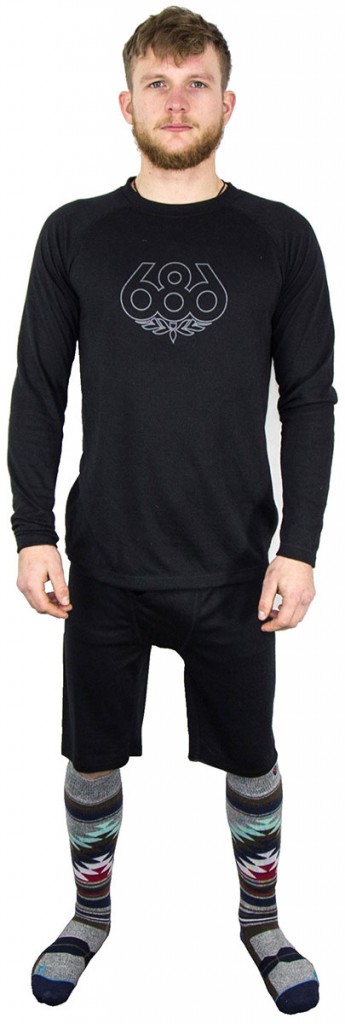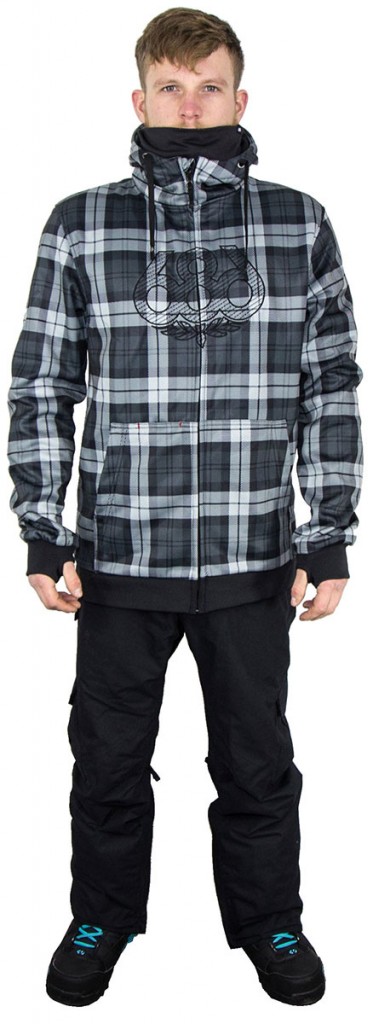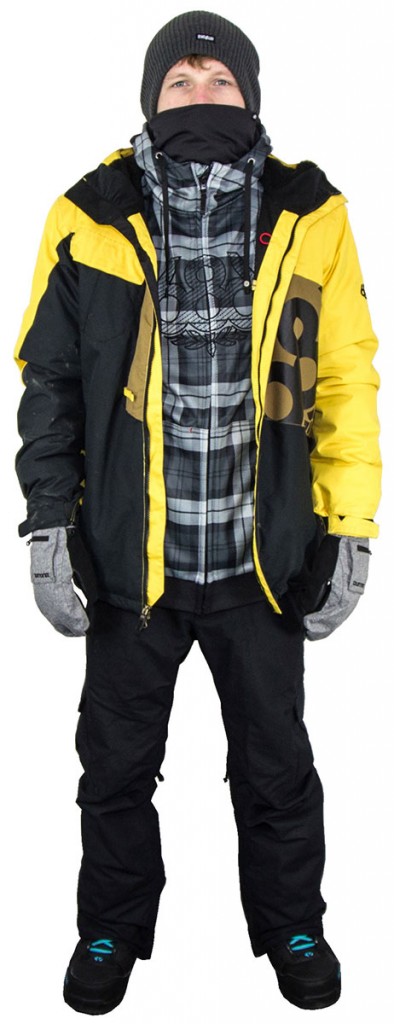Staying fresh on the mountain top
ATBShops Guide to Snow Clothing
So if you remember the basics behind snow clothing you might just come out of this dry and toasty! Don’t think too over the top in regards to keeping warm, your gonna be flying and moving around a lot which will generate a lot of body heat, not to mention if your on the light side of the mountain! Generally in snow sports you tend to use a layering system which consists of three layers; Base Layer, Secondary Layer and your Third (shell) Layer which we will go more in to after.
The reason we do not simply wear thicker clothing is you never quite know the level of exercise your going to be doing and how much body heat you are going to generate. Thicker clothing generally means less breathability which then means if you begin sweating from overheating, you are going to drench yourself from the inside out and freeze without having the ability to simply remove a layer to cool down.
A few notes before we move on:
Understanding waterproofing and breathability
If you get drenched you WILL freeze and more impotently not enjoy yourself, so understandably waterproofing and breathability is a vital element when choosing snowboard gear. The way to understand the waterproofing that clothing gets treated with pretty much results in the higher the numbers the more water proof the garment. Waterproofing is usually measured in millimetres: beginning around 5,000 and ending close to 30,000 for a normal rating, however brands such as Burton and their AK range featuring Gore-Tex technology, usually do not have a waterproofing measurement as they are shown to be 100% waterproof and breathable.
Breathability ratings measure how much moisture can pass through the jacket from the inside, “venting” any build up of sweat. This is measured using grams, centimetres and GM to which is more commonly used throughout the industry alongside the waterproofing measurement, e.g. 10,000/ 10,000MG. Breathability can range anywhere from 5,000GM to 25,000GM and again, the higher the number the more breathability the fabric is.
Things to look out for when purchasing snow clothing
RECCO is a small reflector that some brands stitch in to their clothing/ equipment as a form of locating you in the case of an avalanche.
Ventilation Zips/ Pit Zips/ Test-i-cool are used to vent out any built up hot air for a quick and effective cool down.
Powder Skirts/ Gaiters are designed to keep out any unwanted snow from running up your back or leg using elasticated skirting that wraps around your waist and boots.
Taped Seams/ Waterproof Zips are an awesome feature to keep out any unwanted water leaks seeping through the stitching of the garments.
Moisture Wicking Liner is an affordable luxury that is well worth the money. These materials assist in keeping you dry by wicking any moisture created via sweat, from your skin and pushing it outwards through your layers.
Pant- Jacket Interface is ideal for preventing your jacket running up your back after a crash. These usually consist of small velcro straps on your jacket that hook into small looks on you snow pants.
Utility Pockets are an advantage but don’t rely too heavily on the thought of taking loads of stuff out with you on the mountain as you want to be as lightweight as possible. A pocket for your phone, keys, lift pass and maybe a GoPro will be the most you’ll need.
 |
Your base layer is your first line of heat generation for your body so getting it right may be the difference between having a cold, wet and miserable session, or being warm, dry and comfortable. This all comes down to the fabrics you choose for your base layer: Merino wool or synthetic materials such as Polypropylene are great sweat wicking materials used in a lot of todays snow kit as they also trap warmth generated from body heat. Any light weight material designed to trap warmth while releasing moisture will make a suitable base layer. Try to avoid cotton based layers as once wetted, the material looses any heat trapping properties.
Thermal shirts are a much needed necessity of the snowy world and designed to keep you warm and dry at the same time. They are a cheap yet very effective source of heat when keeping your core temperature up.
Thermal leggings, long johns or joggers are another effective source of heat however are not as much of a necessity as thermal shirts, however wont go a miss during colder conditions or when riding the shadow of the mountain.
Snow socks are probably one of if not the most vital element of your base layer, keeping your feet warm, dry and protected is key to a more comfortable boot fit and shock absorption. Your feet go through a lot when on the slopes which may cause them to sweat a fair amount, regular, every day thick socks lets say, may absorb the sweat without expelling it, leaving a layer of cold soggy fabric wrapped around your feet, which is the last thing you want on the face of a mountain. Thinner socks are a good choice for any boot that has it’s own heavy insulation however it is highly recommended that you stick to snow socks as they offer sweat wicking tech to keep your feet dry, therefor warm. Not only this but snow socks are also well know to be incredibly comfortable! |
Secondary Layer
 |
Your second or mid layer acts as insulation for your first whilst continuing to push any moisture out. This is where you may want to take account the breathability of your next choice of clothing; fleece and wool jumpers are a warm, light weight and breathable choice. Idealistically your mid layer is your choice of removable clothing for when things get too hot.
Jackets, fleeces and jumpers are used as your second layer, although waterproofing isn’t necessarily needed it certainly wouldn’t go a miss for keeping dry. Aim for this layer to be a lightweight, breathable form of insulation and nothing too thick and heavy that will make you sweat a lot. The same rules apply as your first layer; no cotton or absorbent materials as this will expel more heat through holding moisture.
Snow pants or salopettes are a vital necessity of the mountains. They provide an insulated, strengthened, waterproofed and slightly more expensive alternative to regular trousers, but again, they are needed. When choosing your pants make sure they fit snugly around the waist without a pinching in the crotch area, as this can cause an obvious discomfort after four or five hours hiking or on the slopes. Ideally aim for a pant that has gaiters at the cuffs to keep the snow from running up your leg and vent zips for a quick and effective cooling down solution.
Snowboard boots are a specialised boot specifically designed to snowboarding. You cannot replace these with your every day boot as they lock your foot into a near 90 degree angle, keeping your foot solid when attached to the board via the binding. This prevents any unnecessary bending or twisting of your ankle and helps maintain a stance on the board. When choosing your boots there are a few points you may want to consider before purchasing:
- Choose comfort over fashion. This will determine the difference between getting blisters or not, just think you’re going to be spending a lot of time in these boots, if they’re not comfortable then they’re definitely not going to be after five hours or so of riding and walking.
- Avoid “heel lift”. Make sure your heel is firmly locked in place against the soul of the boot when applying pressure to your toes as heel lift will result in some pretty nasty blisters!
- Make sure your foot is secure and does not slide around inside the boot as this does not offer a secure fit and may cause discomfort and wear away the inside of the boot dramatically.
- Heat mouldable liners are used in a lot of todays snow boots and mould to the general shape of your foot for a more comfortable fit. This service is available at most ski/ snowboard shops (we can also do this in store).
|
Snowboard Outerwear
 |
Now this is your shell layer, designed to keep you protected from whatever the elements throw at you leaving three boxes that need to be ticked; waterproof, breathability and lightweight.
Beanies are a great way to keep your head and ears warm and can be warn under your helmet. They are also a pretty ideal thing to have for when your out and about.
Snow jackets, alongside your snow pants are that much needed garment for the mountainous world. This is the layer that protects you from the elements, keeps you dry, keeps in the warmth and expels any remaining moisture. Again these cannot be replaced with your typical everyday jacket and we would strongly advise considering the following points when choosing a jacket:
- Waterproofing and breathability, we cant stress it enough, if you get wet, you WILL get cold.
- Don’t go for anything heavily padded with insulation as this will reduce the breathability of the garment, increase the weight and may result in you over heating. Your snow jacket is one layer you ideally don’t want to remove to cool down.
- Zipped/ buttoned pockets are ideal for any person on the slopes, it is always handy to keep your phone on you incase of an emergency, not to mention your keys, lift pass etc etc. But you want something you can safely secure them all in without worry.
- Pitzips are a truly awesome feature and a super effective way of cooling down quickly!
- Waist gators are great for keeping the snow from running up your back! These are elasticated skirts that are built in to some jackets and are sometimes removable.
- Jacket-to-pant interface are also an effective measure to check out when picking a jacket. This prevents your jacket from running up your back when sliding after a fall and exposing your base layer to the snow.
Gloves are a vital element for snowboarding and we recommend taking at least two pairs (as one will always get wet). Waterproofing and insulation is the ideal solution for choosing gloves, if your new to snowboarding your going to be putting your hands down a lot so look for some thing that will fit nicely under the cuffs of your jacket and will prevent snow from getting in. You can often kill two birds with one stone in regards to gloves; wrist guards are a cheap safety measure that may just keep you out of the foreign A&E walk in centre during your trip. You can find gloves that have removable, integrated wrist guards (which for anyone starting off in snowboarding is ideal). |
A quick note on the waterproofing of your garments, it does not last forever! If you have purchased your kit second hand it may be worth re-waterproofing all your kit ready for the season! You don’t want to get caught out in the cold! Here is instructions on how to go about doing so!
So now you know the in’s and outs of snow clothing and hopefully are fully capable of choosing your setup in confidence. Just remember the three vital elements of snow clothing and you can rest assured knowing your ready for the mountain! Waterproofing, layering and breathability! Follows is a list of snow clothing from head to toe available online or come check it all out in store!
Having trouble choosing a snowboard too?! No problem! We’ve got you covered! Check out our guide to Choosing a Snowboard!
Author: ATBShop
http://www.atbshop.co.uk Established in 2000, ATBShop.co.uk has over a decade of experience in extreme sports. We are based in Swindon, UK.









